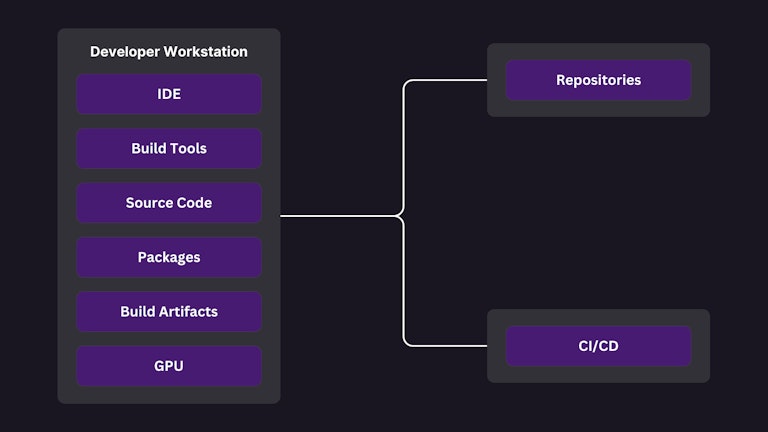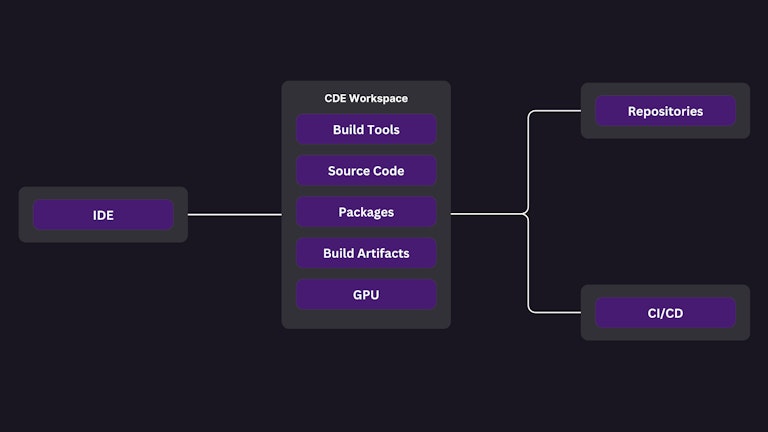What is a Cloud Development Environment?
A cloud development environment (CDE) platform combines development environments with cloud technologies to improve developer experience while keeping costs in check.

A cloud development environment (CDE), sometimes called a cloud-based development environment, is a platform that provides developers with these things:
- Predefined workspaces that are decoupled from their physical workstation
- A comprehensive and consistent set of development tooling
- High performance remote resources to develop and build their projects on
For developers, a CDE provisions environments that are ready to use and consistently reproducible. For platform engineering teams and the enterprise organization that pays for it, a CDE reduces support costs and cloud spending.
Software has changed, development hasn’t
Conventional development setups worked great for decades but things have changed. A typical software project is now a mix of tooling, compute, storage, and other services that can’t practically run locally.

The consequences of conventional development have become obvious:
- Long onboarding. To mitigate this, platform engineering teams document the procedures for installing and configuring the environment, but it’s still up to the developer to follow these steps precisely.
- Inconsistency. Installation and configuration procedures are error-prone. Developers prefer different tooling or aren’t aware of mismatched versions. What runs error-free for one developer might not work for another.
- Expensive hardware. The developer’s workstation does a lot of the heavy lifting. Also, specialized hardware sits idle (while still running up charges) when developers aren’t at the keyboard. Or developers wait for access to resources during peaks in demand. Or to simplify support, the platform engineering team outfits each developer with the same hardware even when only a few developers need it.
- Geography. Network latency affects access to centralized development resources, which affects developer experience.
- Supportability. Expanding a project’s scope makes it difficult to maintain developer infrastructure.
These problems are so common that teams accept them as the cost of doing development.
The cloud is for development too
Meanwhile, the cloud and distributed computing have brought on excellent declarative tools to configure and provision the applications that are being developed. These powerful, proven tools let devops teams configure an application once to create performant, consistent, scalable, cost-efficient runtime environments.
Why can’t developers get the same benefits for their dev environments?
The answer: they can! CDEs use the same principles and technologies for developers.
For example, a CDE can run a template to set up an entire development environment, with tooling and high-performance resources already configured. And when the developer has pushed their commits at the end of the day, the CDE can release the resources they’re no longer using.
A CDE brings modern cloud and distributed capabilities to software development itself. It’s a layer of abstraction that frees the developer from the tedium of onboarding and configuration, consolidates infrastructure for the platform engineering team, and reins in cloud and hardware spend for the organization.

The developer’s point of view
When it’s done right, a CDE automates the tedious, error-prone parts of setting up a development environment. It handles the software provisioning and access to hardware and services. All the developer has to do is click a button in their web browser to start a workspace with the tooling, packages, repos already configured and updated.
Modern IDEs are built for exactly this. They give a developer a responsive local experience while seamlessly connecting to cloud resources.
The platform engineering team’s point of view
A platform engineering team can focus on improving developer experience and productivity. The goal is to provide a single place to develop templates, administer workspace usage, and control user access.
A platform engineering team can use a CDE to deploy consistent developer environments, pre-build projects, and provide other improvements to development environments.
The enterprise’s point of view
Paying for the resources and services of an enterprise-level software project gets expensive. At Coder, we’ve seen enterprise organizations save hundreds of thousands of dollars a year just for cloud services for software development. At the same time, organizations can always meet demand for these services, even when they spike.
The key to solving both of these problems: A CDE spins up resources when needed and tears them down when they’re not. The enterprise pays less for hardware and services. Developers get the resources they need when they’re needed. Equipping developers is less expensive, too. An enterprise can standardize a team on modest hardware that only needs to run an IDE. A developer can even choose to work on a large project from something as simple as a tablet.
Stay tuned for more content on the basics of CDEs, coming your way in the weeks ahead!
Subscribe to our newsletter
Want to stay up to date on all things Coder? Subscribe to our monthly newsletter and be the first to know when we release new things!


